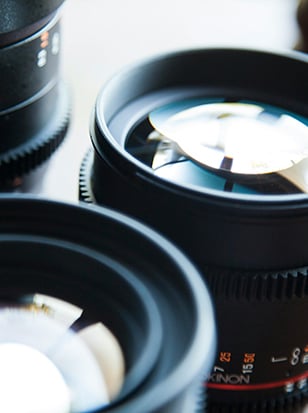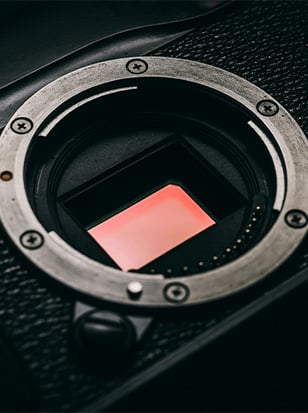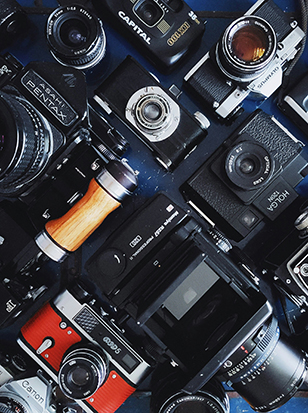
The original Canon EOS R5 represented a gigantic step forward for professional photography and video – and now, the Canon EOS R5 II has arrived to do it again. The latest generation of Canon’s professional high-resolution model is here, boasting a raft of new features that make it arguably the most technologically advanced camera we've ever seen.
Just about every aspect of this camera has been upgraded and reworked to meet the demands of professional image-makers in 2024. There are things that the Canon EOS R5 II can do that, currently, no other camera on the market can do.
We’re sure you’re eager to learn more, so let’s dive straight in and start unpacking the brand new Canon EOS R5 II.
Canon EOS R5 Mark II Digital Camera Body
The Canon EOS R5 Mark II sets a new standard for visual storytelling with industry-leading technology for hybrid creators. It combines a revolutionary 45MP back-illuminated stacked sensor with DIGIC Accelerator technology, rapid speeds of up to 30fps, and 8K60P RAW video recording to deliver a genre-defying mirrorless body that will help professionals achieve their most creative ambitions yet.
£4,499.00 View
What’s new?
At the core of this full-frame mirrorless camera is an architecture called “accelerated capture”. Essentially what this means is a dual processor combo, with the new DIGIC Accelerator processor pairing with a DIGIC X processor (the previous model just had the DIGIC X). It’s this new combination, combined with deep-learning AI algorithms, that powers the new things this camera can do.
Take resolution. At first glance, the resolution specs look the same, with the EOS R5 II boasting a 45MP just like the original EOS R5. However, the EOS R5 II can use its deep-learning algorithms to push this up to 180MP with in-camera upscaling and denoising. This feature also means you can crop right into your images, and then use the upscaling to output an image with essentially no loss of detail — perfect for printing. The sensor is also now a stacked, back-illuminated design, as first seen in the EOS R3, boosting readout speeds.
There are also a number of other minor but welcome improvements made across the board. The EOS R5 II’s in-body image stabilisation (IBIS) system can provide up to 8.5 stops of effective compensation, up from 8 stops on the EOS R5, and its sensor delivers 15+ stops of dynamic range, an increase from 14+ on the EOS R5. The viewfinder is big and beautiful, with 5.76 million dots of resolution, 0.74x magnification and blackout-free shooting.
Shutter speeds have also received a major bump — the Canon EOS R5 II is capable of a maximum shutter speed of 1/64,000sec, which is faster than any other Canon camera, and indeed cameras from most brands — only the Sony A9 III is currently on par with it. In burst mode, the EOS R5 II can manage a maximum rate of 30fps with the electronic shutter, up from 20fps on the EOS R5. There’s also the option of a 15fps pre-burst mode, allowing you to capture a few frames from just before you hit the shutter button, in RAW and JPEG. Professionals will also welcome the improvements to FTP (file transfer protocol), which now allows you to send multiple images simultaneously.
However, the big upgrades have come in two key areas — autofocus and video. Let’s take a closer look.
Autofocus
Canon has long had a deserved reputation for top-tier autofocus, with its Dual Pixel Autofocus system delivering absolutely outstanding speed and accuracy. The EOS R5 II represents the next evolution of this tech, and it has been appropriately rebranded as Dual Pixel Accelerated AF.
With 5,850 AF points, the camera covers 100% horizontal and 90% vertical with manual selection, and 100% vertical with tracking. It’s capable of working in conditions as dim as -6.5EV. We also once again see the inclusion of intelligent, AI-powered Subject-Detection autofocus, which can intelligently recognise specific subjects like people, animals, insects and vehicles.
However, the big headline feature is “Action Priority”, which uses deep-learning AI to intelligently assess and predict a subject’s movements. This is an absolute gift for sports photographers, because the system is capable of intelligently keeping track of the key focal point in a shot. For instance, if a frame is crowded with basketball players, it can intelligently focus on the player that currently has the ball.
This also works in tandem with a feature that got a lot of play in the release of the EOS R3 — Eye Control AF. If you don’t know, this is a wichcraft-like feature that moves the focus point by following the movement of your eye in the viewfinder, meaning the camera literally focuses wherever you’re looking. All these features combine to deliver an autofocus system that reads your intentions better than ever before, keeping you in the moment and increasing your hit-rate, even in busy and complicated scenes.
Video
The original EOS R5 made headlines for its capacity to shoot 8K 30p video, and the EOS R5 II pushes things further. It’s able to capture 8K 60p RAW video in 12-bit, as well as 4K video in 120p and 60p (oversampled from 8K). In 8K you can record DCI, UHD and ProRes. Recording formats include C-Log2, C-Log3, XF-HEVC, XF-AVC S and HLG. There’s four-channel audio recording, linear pulse code modulation (LPCM) and 24-bit audio. XLR Tascam is also available. The camera is compatible with Canon’s EOS VR system, with VR playback available.
The big headline feature is simultaneous recording — capturing photos and video simultaneously, using the dual card slots to record the two formats to separate cards. While there are understandable limitations to this feature, as you have to record movies in 2K and stills in JPEG, it’s something genuinely new that has the potential to radically transform the workflow of professional photojournalists and sports shooters.
The Canon EOS R5 II represents an exciting step forward for image-making in photo and video, and we’re hugely excited to spend more time hands-on with it in the coming weeks. Click here to visit our Canon launch page.
FAQs
How does the Canon EOS R5 II differ from its predecessor, the Canon EOS R5?
The Canon EOS R5 II features a dual processor setup with the new DIGIC Accelerator and DIGIC X processors, enhancing performance with deep-learning AI. It offers 180MP upscaling, faster readout speeds, and improved stabilisation up to 8.5 stops.
How has the autofocus system been improved in the Canon EOS R5 II?
The Canon EOS R5 II introduces Dual Pixel Accelerated AF with 5,850 AF points, AI-powered Subject-Detection, and "Action Priority" mode for tracking subject movements. Eye Control AF enhances focus precision by following eye movement in the viewfinder.
What are the video capabilities of the Canon EOS R5 II?
The Canon EOS R5 II records 8K 60p RAW video internally, along with 4K at 120p and 60p, and it supports various recording formats and four-channel audio. It also offers simultaneous photo and video recording, enhancing workflow for professionals.
How does the Canon EOS R5 II handle dynamic range and image stabilisation?
The Canon EOS R5 II provides 15+ stops of dynamic range and improved IBIS up to 8.5 stops, resulting in super-detailed images and smooth video even in difficult shooting conditions.
What are the shutter speed and burst mode capabilities of the Canon EOS R5 II?
The Canon EOS R5 II has a maximum shutter speed of 1/64,000sec and a blackout-free burst rate of 30fps with the electronic shutter. It also features a 15fps pre-burst mode, capturing frames just before the shutter button is pressed.
Buying Guides








